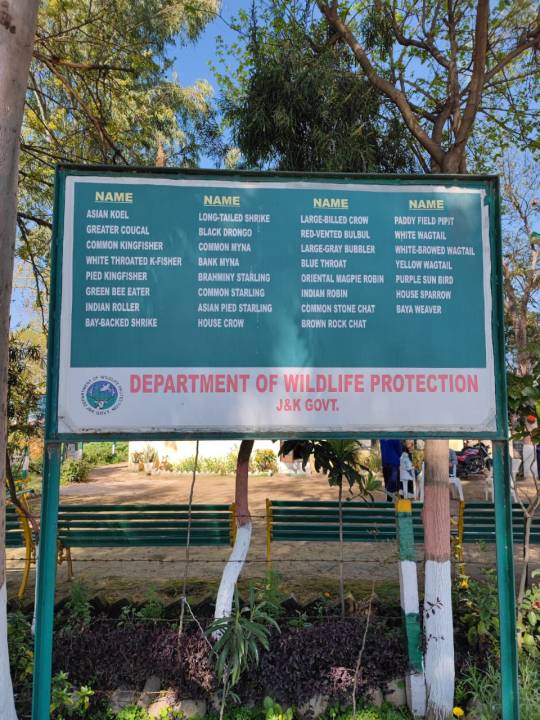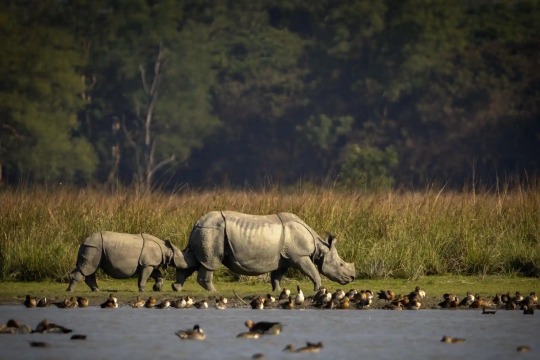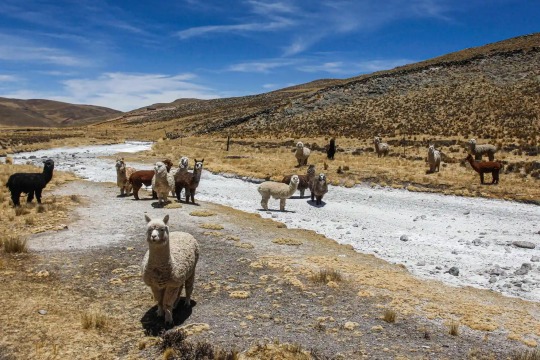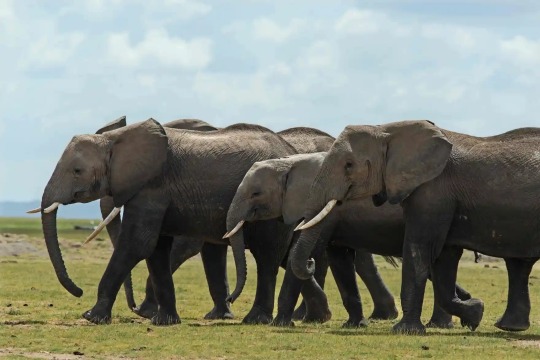#gharanas
Text
High praise coming from the world's harshest Auntie.
Shop Gharanafoods.com/desiquest for deliciousness!!!
EPISODE 3 IS LIVE!!! @ DesiQuest.com/Watch
ft. Anjali Bhimani, Rekha Shankar, Jasmine Bhullar, Sandeep Parikh
8 notes
·
View notes
Text
Sighting At Gharana Wetland With Friend
On last saturday, my friend suggested a trip to Gharana Wetland.
He and me rode on Royal Enfield Meteor 350 joyfully with a Go Pro camera with us. On way he told me that this place was about 35 km far from Jammu city and it is located near Indo - Pak border in R S Pura Tehsil of Jammu Distt .
It is barely 4 km away from Suchetgarh border. He told me that Gharana Wetland has an international recognition. It is one of the important bird areas in the world declared by the Bird Life International (UK) and also by the Bombay Natural History Society.
This wetland is located along Central Asian Flyway. Looking into its importance it has been notified as Wetland Conservation Reserve under J&K Wildlife Protection Act 1978.
But on asking where do the birds come from, he told me that these migratory birds are from Central Asia , Mongolia , Russia , China etc. Most of these birds reach there between the last week of October and the first week of November. The maximum number of birds which may go upto 5000 can be seen in December and January, but between ending February and first week of March they start returning back to their native places.
The different type of species which may go around 90 are bar-headed geese , common teals , gadwallas , purple swamp-hens , green shanks flocks , indian morhens etc.
While we were about to reach Gharana Wetland , my friend told me that it had the unique characteristic of being the only one Wetland in the world where bird watchers can watch from a close distance such bird species which have the capacity to fly high and reach high altitudes .
All this narration made me excited and much curious to see all this myself . By then we arrived at the periphery of the Wetland and could see the signage of Department of Wildlife Protection with names of species on it.

Signage of Department Of Wildlife Protection
We parked our Royal Enfield Meteor 350 and entered the Gharana Wetland. I was awestruck with magnificent view that opened in front of me , a reservoir of biodiversity with hundreds and hundreds of birds were in front of me which I had never seen before . I was thrilled to see all this. I could hear chirping and chattering of birds all around me.
I wondered that how these birds travelled thousands of miles to reach Gharana Wetland. At the same time I saw a flock of birds flying high in front of me chirping sweetly in their own way.
Flock of birds flying.
Using Binoculars I also saw Pak post from the Wetland where I was told some birds fly at night and return in the morning. Meanwhile it was about to get dark and we had to return.
On way , the images of the place were still flashing in front of me. It left me thinking that how good it would be that we humans also learn to live together and give a message that world is one family .It was indeed a journey of a lifetime and undoubtedly a wonderful trip.
3 notes
·
View notes
Text
Patiala Gharana : A Legacy of Classical Excellence
The Patiala Gharana is one of the most distinguished schools of Indian classical music, particularly in the realm of Hindustani classical vocal music. Originating from the princely state of Patiala in Punjab, this gharana has made significant contributions to the rich tapestry of Indian music.
0 notes
Text
Raahein Gharana: A Pathway to Preserve and Promote Heritage Music and Musicians

Raahein Gharana is revolutionizing the way we connect with and preserve traditional music. This initiative is dedicated to championing heritage musicians and their unique art forms, ensuring that these cultural treasures continue to resonate through the ages.
Through dynamic events, educational programs, and live performances, Raahein Gharana provides a vibrant platform for artists to share their craft with new audiences. By spotlighting the rich traditions of heritage music, the initiative fosters a deeper appreciation and understanding of these musical legacies.
To get a glimpse of Raahein Gharana’s impactful work, check out this inspiring video. This video captures the essence of the initiative and its commitment to preserving musical traditions.
youtube
In a world increasingly dominated by modern influences, Raahein Gharana stands as a beacon of cultural preservation, dedicated to keeping the spirit of heritage music alive for generations to come.
Join us in celebrating and supporting the enduring beauty of traditional music through the Raahein Gharana initiative.
Follow and Subscribe Raahein Gharana YouTube channel.
Read full blog: Raahein Gharana: A Pathway to Preserve and Promote Heritage Music and Musicians
1 note
·
View note
Text
Pt.Balabhau Umdekar Kundalguru
Pandit Balabhau Umdekar Kundalguru, the esteemed founder of Chatur Academy of Indian Music, is celebrated for his extraordinary contributions to Indian classical music. A legendary maestro, his teachings and legacy continue to inspire and shape future generations, making him a monumental figure in the realm of traditional Indian music education.
Pandit Balabhau Umdekar was born on August 5, 1901, to the celebrated musician Pt. Nattubhaiya Umdekar. Tragically, he lost his father at the tender age of five, forcing him to embark on his musical journey alone. Despite the harsh conditions, including freezing mornings where he would use two puppies to keep warm on his way to training, he remained dedicated. He would leave early and return late, receiving rigorous training under legendary maestros such as the late Balasaheb Guruji, Ustad Nissar Hussain Khan Saheb, and Pt. Mahadev Shastri.
Pt. Balabhau Umdekar was appointed as the court musician for the Gwalior Court of the Scindias, where he became one of the highest-paid musicians of his time. His house was filled with gold utensils, gold items, and jewelry, reflecting his success and prestige. His musical prowess was matched by his wife, Radhabai Umdekar, a proficient sitar player. They had six children, all of whom became accomplished musicians: Late Smt. Sangeeta Kathale (SumanUmdekar ), a famous vocalist; Late Smt.Vimal Belapurkar, a violin player; Late Smt.Indumati Telang, a sitarist; Late Smt.Kamal Mandal, a vocalist;Late Pt.Madhav Umdekar, a renowned vocalist; and Pt.Shriram Umdekar, a top-grade artist skilled in Rudra Veena, Surbahar, and Sitar. Today, Pt. Shriram Umdekar's daughter Dr.Radhika Veenasadhika first lady Vichitra Veena Player and Smt.Geetika Masurkar a known vocalist and granddaughter Miss Aarohi Budhkar Vichitra Veena Player continue Pt.Balabhau Umdekar "Kundalguru"'s legacy.
Pt.Balabhau Umdekar trained many famous students, including Pt.Sharadchandra Shridhar Paranjape, Pt.Bhaskarrao Sangit, Pt.Babu Shastri, Pt.Gangadhar Bhagwat, and Pt.Raghunandan Sant. In 1927, he founded the Chatur Academy of Indian Music and authored over 15 books. He also established the Chatur Sangit Mahavidyalay, contributing significantly to Indian classical music education. Pt.Balabhau Umdekar passed away on 8th June 1968 due to illness. His Chatur Academy's legacy lives on through the Veena Venu Art Foundation, continuing to inspire and nurture future generations of musicians. Even today, the Pt. Balabhau Umdekar Smruti Sangeet Samaroh is celebrated in his memory by his son, Pt. Shriram Umdekar.
Pt.Balabhau Umdekar (Kundalguru)was renowned for his sweet yet strong voice, powerful enough to be heard from 100 feet away. He was also known as "Kundalguru" due to his miraculous recovery from a severe illness after his wife received gifted kundals from a saint who was later nowhere to be found. These kundals made him fit within a day when medicines had failed. His remarkable life and contributions have left an indelible mark on Indian classical music. He remains to be an inspiration even today.
0 notes
Text

Anthony Fineran (B 1981), Hinda Gharana Bay, 2023
0 notes
Text
Raag Darbari Kanra: Fateh Ali Khan
Raag Darbari Kanra: Fateh Ali Khan
Fateh Ali Khan of the Gwalior gharana is arguably Pakistan’s greatest living classical singer. And yet he is a bit of a mystery man. There is precious little by way of biography on the net and it appears he will always live in the shadow of the other great Fateh Ali Khan, half of the mighty sibling duo of Amanat Ali and Fateh Ali (Patiala gharana) fame. One of the highlights of my musical life…

View On WordPress
0 notes
Text
"The status of Two-spirit people as a group often cited as examples of non-binary gender in non-Western cultures -usually without due regard for the spiritual aspects of their experience- is shared by another group of people on the other side of the world, who also remain marginalized today. The origins of these people's spiritual power have been attributed to the ancient Hindu epic, the Ramayana. . . . Hijras -people living on the Indian subcontinent who present in a feminine way, often perform on the street, and frequently live in structured gharanas (lineage groups) made up of a guru (leader) and group of chelas (disciples) - are, like Two-spirit people, often cited as examples of non-binary gender in non-Western cultures. This isn't entirely inaccurate; hijras understand themselves, and are understood by their wider culture, as not men or women. But only rarely do these casual references to hijras address the fact that many aspects of their identity and lived experience are rooted in religious belief and practice. The story from the Ramayana is disputed. . .but belief in the situation it seeks to explain, the ability of hijras to confer divine blessings, is very real. Hijra's infertility . . . gives them the ability to confer -or to curse- the fertility of newly married people or of newborn babies. Consequently, they have long acquired much of their income by visiting households at these times to collect badhai (alms). Their visits are seen by the public as auspicious, bringing good luck and the blessings of the goddess Bauchara Mata. . .
As well as their Ramayana origin story, many Indian hijras express identification with Hindu figures who combine genders, including the deity Shiva. . . More than any other Hindu figure, however, hijras are affiliated with the goddess Bahuchara Mata. It is she who grants them their power to confer blessings; she to whom they pray for successful surgery; and she whom they worship above all others. Moreover, for many, it is she who 'calls' people to become hijras -underlining the fact that hijras identity, much like Two-Spirit identity, can be rooted in spirituality from its very beginnings."
-Before We Were Trans: A New History of Gender by Kit Heyam
45 notes
·
View notes
Text
It is said that conventional conceptualisations of family and marriage are facing evolutionary challenges. This argument is based on the idea that a family comprises two parents of the opposite sex and their two children. This argument makes it seem as though new forms of marriage which are non-heterosexual are new. They are not. The hijara 'gharana' system, maitri karar and other forms of alternative familial structures have existed for a long time in the sub-continent.
Rohin Bhatt, ‘A case for marriage equality’, Hindu
7 notes
·
View notes
Text
Musalmaan Ammi Hindu Lund
Ahmed ki Ammi aur uska muslamaan gharana
Mera naam Ahmed hai aur mai 22 saal ka ek neak shareef musalmaan ladka hoon, Mere abbu dubai me rahte hai aur Meri Ammi SHABANA behad haseen aur mohazzib khatoon hai. Meri 2 behne hai Ek Afiya baji jinki shadi 3 saal pahle hui aur ek beta hai 2 saal ka aur dusri Zubeda jiska nikah hone wala hai.
Ye un dino ki baat hai jab choti behan Zubeda ki shadi ka mahool tha, badi behan Afiya baji apne 2 saal ke bache rehan ke sath aayi hui thi, mere jiju aslam ghar ziyada nahi aate isliye Afiya baji ko bheje kar apni zimmedari se fariq hogaye, Choti behan Zubeda apni shadi ki khushi me khawabo me raha karti thi. Ammi ghar ki zimmedari aur ghar ke sare kaam me hamesha masroof rahti thi, hamare ghar ka naukar Ramesh subah savere aajaya karta tha use kafi madad milti thi hume.
Lekin shadi ke mahool me mai akela in sub kaamo se kafi masroof raha karta tha. Ek baar mai samaan lene bahar nikla mere bachpan ka dost Raghav raste me mila.
Raghav : Abey ahmed saale dikhta nahi aajkal kidhar hai
Ahmed : arey puch mat yaar Raghav kaam itna hai ke kya kahu
Raghav : kyu be shadi hogayi kya teri aise bolraha hai
Ahmed : nahi choti behan Zubeda ki shadi hai 10 din baad usi me busy hoon.
Raghav gussa dikhate hue..aby saale to bol na apne dost ko mai kab kaam aaonga kahte hue meri bike ke piche baith gaya, mai apne sache dost Raghav ko lekar apne ghar aaya, raghav ko sub hi jante the isliye mai use apne ghar le aaya, ghar aate hi Raghav aise mere ghar me ghus gaya jaise usi ka apna ghar ko mujhe acha laga ke mera dost mere ghar aaya hai meri behan ki shadi me madad karne.
Ammi : arey Raghav beta kaise ho ab yaad aayi hai hamare ghar aane ki.
Raghav :arey aunty ye ahmed kuch batata nahi, aaj bola ke zubeda ki shadi hai, pucho isse zara,, bol be ahmed.
Ahmed : arey bhai galati hogayi ab jane bhi de.
Afiya baji : Ahmed zara jakar ye samaan le aa (kahte hue raghav singh ko dekh kar) oho janaab kaise hai raghav.
Raghav : Afiya baji aapki shadi kya hui aap to bhool hi gayi kahte hue Afiya baji ke haseen namazi seene per halki si Nazar daali.
Ahmed ke dil me ajeeb sa hua lekin Afiya baji 28 saala ek bache ki ammi hai wo apne aap ko mahfooz rakhna janti hai, Ahmed ne itna dhyan nahi diya lekin Raghav singh Afiya baji ki Namazi chut ka pahle se ashiq tha.
Itne me Ahmed ka bhanja Rehan zidd karne laga ke usko dukaan se chocklate chahiye
Raghav ne bhanje ko apni godi me uthaya, arey kya pyara hai Afiya baji aapka ye chotu moto kahte hue dukaan lejakar laata hon kahte hue usko lekar dukaan chala gaya aur Ahmed apne ghar ke kaamo me lag gaya,
Ahmed ki behan Afiya baji Shalwar kameez pahne namazi gol Islami 36 ka seena, 30 ki kamar aur namazi 40 ki Gol Gaand badi haseen lagrahi thi, itne me Raghav Ahmed ke bhanje rehan ke le aaya aur afiya baji ke paas lejakar halke se kaha Rehan ka khayal hamesha ache se rakhna, Afiya baji halki se Nazar se Raghav ko dekhte hue, hamesha rakhti hon isme mujhe tum hi Nazar aate ho, Ahmed ko pata hi nahi tha ke ye Afiya aur Raghav singh ki najayaz mohabbat ki nishani hai
Itne me ghar ka Naukar Ramesh aakar Afiya baji se paise mangne laga
Ramesh : Afiya bibi Shabana bibi ne aapko paise dene ko kaha.
Afiya : Ramesh mai abhi lati (kahte hue Afiya apna namazi Nazar Raghav ki nazro se mila kar chali gayi.
Raghav : Kya be Ramesh kaisa kaam karraha hai ghar me?
Ramesh : kya bataon meri patni roz mujhse jhagda karti hai mera dimaag kharaab hojata hai (itne me Ahmed ki Ammi aate hue sun leti hai)
Ahmed ki Ammi : arey Ramesh tumko boli hoon kayi baar ke aise tension nahi liya karte har baar jhagda hojata hai bechara Ramesh ka hamare dekho kaise parshan rahta hai (Ahmed ki Ammi ki hamdardi aur Ramesh ka akelapan ek naya mod leraha tha Ahmed ke ghar me).
Ahmed niche seedhiyo ke paas khada aur jab Ramesh afiya se paise lekar niche aaraha tha tab Ramesh ki dhoti se uska Uncut pyasa bhagwadhari lauda latakte hue Nazar aane laga aur jaise hi Ramesh niche aaya
Ahmed : abye Ramesh tu pagal hai kya sidhe kapde pahen ke aya kar buddhu
Ramesh: Ahmed baba dusre itne kapde hai nahi aur bina dhoti ke lungi ke mujhe kaam karna nahi aata (kahte hue bahar samaan laane chala jata hai)
Ahmed Ramesh ka napaak bhagwa sanatani uncut lauda dekh kar pareshan hojata hai ke ye buddhu sa dikhne wala Ramesh ka lauda inta mota aur ajeeb tha ke Ahmed ko apne hi ghar me sharm aagayi.
3 notes
·
View notes
Text
Hijra (South Asia)
Hijra (Arabic: ہیجڑا) is a south asian subcultural identity for transgender women, transvestites (MTF), androgynous male, intersex & non-binary folks. Many Hijras lives in well-organized communities, led by a guru (leader) in Bangladesh, Pakistan, India & some parts of Nepal. Traditionally, hijras are recognized as a “distinct gender” which is different from the normative male & female genders. Most of them are assigned “male” at birth, while a small number of hijras are born intersex and later develop a feminine gender identity or gender ambiguity. Hijras usually present themselves in feminine attire, use feminine names & pronouns for themselves. Some hijras may present themselves in masculine outfits, may use masculine names or vice-versa. Both Izak & Hijragaan are equivalents of the term “Hijra” in Afghanistan. Afghani vernacular term Izak refers to eunuch or people of ambiguous gender/sex. Izak is also used as a slurr against LGBTQI+ community.
Hijra Culture
Hijras has their own traditions, rituals, cults, language & festivities. Hijras typically earn a living through various means, including participating in toli–badhai (ritual blessings), collecting alms, begging, prostitution, dancing & singing at different occasions. These activities serve as common sources of income within the hijra community. Most of the Hijra communities follows a kinship known as guru-chela or guru-shishyaa. This kinship is based on hierarchal relationships of discipleship among hijras, organizing themselves into different dera/gharanas (house). These dera/gharanas serve as social units, provide a sense of belonging and support to gender-diverse folks. Many hijras try to maintain matrilineal relationships within their communities; these relationships include guru ma or ma (mother), daughter, maasi or mausi (aunty), sister, niece, nani or naniguru (grandmother). In hijra community, gurus are revered as mother, parent, guardian & sometimes brother. Chelas are revered as son or daughter of guru. In hijra community, individuals can become members through an ritual ceremony or reet which is very much common within Hijra community. Many transgendered hijras & kothis do castration, emasculation before joining the community. However, community membership is not solely dependent on genital mutilation.
The governing bodies within the hijra/kinner community play a central role in maintaining their cultural practices and traditions. These governing bodies hold influential positions on decision-making and community affairs within communities. They contribute to the overall structure and organization of the hijra/kinner/third gender communities.
The spiritual status of hijras is publicly acknowledged & accepted as a part of their gender identity, entitling them to attain a spiritual level referred to as “others” non-hijras. Prior to arrival of Islam in South Asia, kinners (hindu hijra folks) were elevated to the status of demi-god in Indian subcontinent. They were believed to possess supernatural powers that could bestow fertility and good luck upon those who sought kinner's blessings. Upon their conversion to Islam, kinners adopted the label “hijra” which means spiritual migration, transformation, transcend, liminality. Hijras became great devotees of Sufi saints, such as Khwaja Gharib Nawaz, Lal Shahbaz Qalaander, Baba Bulleh Shah. Most of the hijra folks incorporated their Hindu beliefs into their practice of Islam after their conversion. They visits Sufi shrines, temples, and mosques, as well as participate in pilgrimages. Muslim hijras also maintain a belief in the Goddess Bahuchara Maa. Bahuchara Maa is patron of hijra, kinner, transgender woman, eunuch, transvestite, kothi communities. She is also known as Mai Nandi in Pakistan.
Kothi
The word Kothi is common across India & Bangladesh. Other local equivalents of Kothi are Durani (Kolkata), Meti (Nepal), Zenana/Zanana (Pakistan). While Kothis are often distinguished from Hijras, they often dress as women and act in a feminine manner in public spaces, even using feminine language to refer to themselves and each-other. Sometimes the term Kothi is regarded as person who play passive or submissive role in homosexual relationships. In India, the term Kothi refers to effeminate homosexuals & transvestite homosexuals who take feminine role in homosexual relationship with Panthi (a south asian term for masculine gay/bisexual/straight man, who dates hijras & kothis). Majority of kothis don't live in intentional communities that hijras usually lives in. Some argued that term “Kothi” is an all-encompassing term for homosexual bottoms, effeminate males, trans-feminines, transvestites, trans woman, who do not conform to societal, normative gender roles. So the term Kothi would include the identity of Hijra, among others.
Religious Practices
Many hijra communities practice a form of syncretism that draws on multiple religions, including islam, hinduism, buddhism, sikhism, etc. Both Indian hindu hijras/kinners and muslim hijras are devotee of Goddess Bahuchara Maa. Majority of gurus in hijra community are muslim in Indian subcontinent. Annually they pay homage to Hazrat Khawaja Gharib Nawaz in Ajmer Sharif.According to Gayatri Reddy, Indian muslim hijras do not practice Islam differently from other muslims. Their religious syncretism doesn't make them any less muslim. Reddy also documents an example of how this syncretism manifests: In Hyderabad of India a group of muslim converts were circumcised, something seen as the quintessential marker of Muslim identity.
Guru-chela system is very similar to Pir-Mureed discipleship of Sufism. In Sufi traditions, a Pir/Guru (spiritual guider) takes on disciples known as Mureeds, forming a deep and spiritual relationship. Some believes that south asian hijras adopted this system of mentorship & spiritual guidance within their own community.
In Pakistan, most hijras do not practice religious syncretism. But they have great tolerance & compassion for other religions. Pakistani hijras are more connected with sufi cultures & Mughal cultures. Some prefers the term Khawaja Sara for themselves instead of Hijra, Khusra. They pay homage to sufi dargahs, pray at mosque or dargah (in male outfit). Hijras also perform Islamic Hajj & Umrah in Mecca, until 2017 when saudi authorities ban religious pilgrimage for transgender & third gender folks.
Hijra Farsi Language
Hijra Farsi/Farsi Kalaam is a secret code language of hijra, khwaja sara, & zennana communities. It is also spoken among non-hijra LGBTQ+ members. Hijra Farsi was originated during the Mughal Era. Hijra Farsi is widely spoken among muslim hijras, khwajasaras & zennanas. Hindu hijras/kinner speaks Gupti language. known as Hijra Farsi, Farsi Kalaam. Some parts of India & in Bangladesh, it is known as Ulti Bhasha.
History
Hijra identity & culture are documented to have evolved during the Delhi Sultanate (1226-1526) and Mughal Empire (1526-1707), where they held positions as guardian of royal harems, court officials, entertainers, servant for elite households, manual laborers, political advisors, etc. They had been guardians of many sufi shrines in medieval era.
Since 19th century, hijras were targeted by British colonial authorities who sought to eradicate them, criminalised them under Section 377 (1860) & Criminal Tribe Act (1870). This encouraged anti-hijra sentiments throughout the Indian subcontinent, the legacies of which continued in later days. As a result, people started to viewing Hijras differently. Beginning in the 1850s with the British Raj, colonial authorities deployed various strategies to eradicate hijras, whom they saw as "a breach of public decency." The British viewed hijras as incapable of "moral transformation" & assimilation and therefore subjected them to eliminatory policies. In 1860, hijras became subjected to Section 377 of the Indian Penal Code which allowed British authorities to prosecute hijras for their sexuality. Even though they were already criminalized under the Section 377, authorities of the North-Western Provinces (NWP) sought to enact a 'Special law' against hijras in 1861.
By 1870, no high-ranking British officials argued against the implementation of special legislation to address the 'hijra problem,' thus solidifying a violent anti-hijra campaign all across the Indian subcontinent. Anti-hijra laws were enacted; whereas a law outlawing castration (a central part of the hijra community, although not required for community membership), crossdressing, community gathering, ritual practices. Hijras were included in the Criminal Tribes Act (1871) and labelled a "criminal tribe", now subjected to compulsory registration, strict monitoring, and stigmatization. Because of economic costs, which were the main impetus behind British colonialism, Hijras and other so-called "criminal tribes" were unable to be collectively sequestered from colonial society.
Furthermore, Child Removal Projects, which had already begun elsewhere in the British Empire, like Colonial Australia with the forced removal of aboriginal children for assimilation into white settler society, were brought to India for all 'criminal tribes' officially in 1911. Child removal was already in de-facto practice against hijras since the passage of the Criminal Tribes Act (1871) to initiate the extermination of hijra communities by preventing initiation, since the dominant colonial narrative was that all trans & intersex children were "kidnapped and enslaved". Researcher Jessica Hinchy notes that the elimination oriented tactics carried out toward hijras during the colonial era were comparable to what Patrick Wolfe called the 'logic of elimination' in British settler colonies, such as the USA and Australia, as well as the anti-joya campaigns executed by Spanish colonial authorities against gender-diverse people centuries earlier in the establishment of New Spain (1535-1821). After the independence, hijras survived these barbaric colonial extermination. But the centuries-old stigma & shame continues as a legacy of British colonialism in modern days. In the late 20th & early 21st centuries, hijras became the subject of more attention, being the focus of numerous news features, films, literature, documentaries, ethnographies, monographs, dissertations. Since the late 20th century some NGOs & rights groups lobbied for official recognition of the hijra community.
Legal Recognition in South Asia
Hijra rights in India:
Hijra community is known by different names in Indian subcontinent.For example: Khusra,Khusaraa,Jankha,Zennani in Punjab; Pavaiyaa in Gujrat;Hinjida in Odisha;Dhurani, Brihonnala,Hijre in West Bengal;Khawajasera in Urdu;Ali,Aravani in Tamil Nadu,Khadra in Sindhi,etc.
Hijra is a pejorative term, most transgenders consider hijra as derogatory & some transgenders does not consider it as a derogatory.Indian transgenders often prefer the term ''Kinner'' for themselves.
In 1994, Hijras were legally granted voting rights as a third sex.Due to alleged legal ambiguity of the procedure,Indian hijras has difficulties accessing safe medical facilities for surgery.In 1998 Shabnam Mausi (a muslim hijra) was elected as India's first transgender MLA.
In April, 2014 Indian Supreme Court recognised hijra,transgender,eunuch, & intersex people as a "third gender" in law.The Court ruled that hijras,transgender people have a fundamental constitutional right to change their gender without any sort of surgery, and called on the Union Government to ensure equal treatment for hijra people.The Court also ruled that the Indian Constitution mandates the recognition of a third gender on official documents and that Article 15 bans discrimination based on gender identity.In light of the ruling,government documents, such as voter ID cards, passports & bank forms, have started providing a third gender option alongside male (M) & female (F), usually designated as "other" (O),"third gender" (TG) or "transgender" (T).
The states of Tamil Nadu and Kerala were the 1st Indian states to introduce a Transgender Welfare Policy.According to the policy, transgender & hijra people can access free sex-reassignment surgery in govt. hospitals (only for Male to Female),free housing,various citizenship documents, admission in government colleges with full scholarship for higher studies,alternative sources of livelihood through formation of self-help groups(for savings) and initiating income-generation programmes (IGP).
On 24 April 2015, the Rajya Sabha unanimously passed the Rights of Transgender Persons Bill, guaranteeing rights and entitlements,reservations in education,jobs,unemployment allowances, pensions,legal aids & skill development for Hijras.It also contained provisions to prohibit discrimination in employment as well as prevent abuse,violence and exploitation of Hijra people.Social Justice & Empowerment Minister Thaawar Chand Gehlot stated on 11 June 2015 that the Union Government would introduce a new comprehensive bill for trans rights in the Monsoon session of Parliament. The bill would be based on the study on trans issues conducted by a committee appointed on 27 January 2014.According to Thaawar Chand Gehlot, the Government sought to provide trans & hijra people with all rights and entitlements currently enjoyed by scheduled castes & scheduled tribes.
The Transgender Persons (Protection of Rights) Bill,2016, which was initially introduced to Parliament in August 2016, was reintroduced to Parliament in late 2017. Some LGBTQ+ & hijra activists have opposed the bill because it does not address issues such as marriage,adoption & divorce for trans people.It was passed by the Lok Sabha on 17 December 2018, with 27 amendments, including a controversial clause prohibiting hijras from begging.
In April 2017, the Ministry of Drinking Water and Sanitation instructed states to allow transgender people to use the public toilet of their choice.In October 2017, the Karnataka Government issued the "State Policy for Transgenders, 2017", with the aim of raising awareness of transgender people within all educational institutions in the state. Educational institutions will address issues of violence & discrimination against trans people.
On 28 November 2017, N. Chandrababu Naidu, the Chief Minister of Andhra Pradesh, announced the enactment of pension plans for transgender people.On 16 December 2017, the Andhra Pradesh Cabinet passed the policy. According to the policy, the State Government will provide an amount of ₹1,500 per month to each trans person above the age of 18 for social security pensions.The Govt. will also construct Transgender toilets in public places.
In early 2019, the Social Welfare Department of Assam published a draft "transgender policy" with numerous objectives, including providing transgender people access to educational institutions, providing shelter and sanitation for the homeless, raising awareness, and issuing self-identification identity cards.
Hijra rights in Pakistan
In Pakistan hijra & khawaja sara community has a vibrant culture (both are culturally & historically different identities). In Pakistan, Hijras are sometimes referred to as eunuch, shemale, mukhannath, transvestite, khusra, moorat/murat, khadra, chakka, khawaja sara/sera, intersex, teesri zins (third gender), etc. Hijras faces humiliation & violence on daily basis in Pakistan. Surprisingly, they enjoy a certain level of acceptance & respect due to their position in pre-colonial Islamic empires & spiritual status. Their presence in Pakistani muslim society is usually tolerated. Many khawaja sara & hijras called themselves cultural heirs of the Mughal eunuchs & mukhannaths.
Pakistani society has a common myth regarding the hijra that they are born with congenital conditions, sexual ambiguities & they are incapable of procreation. In 2009, the Pakistan's Supreme Court officially recognized hijra's gender. The landmark ruling stated that as citizens they were entitled to the equal benefit from the federal and provincial governments' financial support schemes. In 2010, the court ordered the full recognition of the hijra/khawaja sara community, including the provision of free medical & educational facilities, microcredit schemes and job quotas for hijras in every government department. But court did not say anything about their protections from discrimination in public services or housing.
On 8 May 2018, the National Assembly of Pakistan passed country's first historic Transgender Person (Protection of Rights) Act, 2018 (مُتَجَنَّس افراد کے لیے (تحفظ حقوق) قانون 2018ء). Transgender Person Act ensure the right of self-identification of one's gender Pakistani gender diverse people may express their gender according to their own preferences, & they may have their gender identity of choice reflected on their documents (including NICs, passports, driver's licenses,education certificates) The act ensures transgender people's "fundamental rights to inheritance, education, employment, vote, hold public office, health, assembly, and access to public spaces and property.
Hijra rights in Bangladesh
When Bangladesh was under Pakistani rule, the state used to provide pensions to the elder hijra community during their old age. This subsidy was initially continued after Bangladesh gained independence, but was later discontinued. In November 2013, Bangladesh officially recognized Hijras as a third gender. Bangladeshi Hijras are often discriminated, harassed due to public exposure of their ‘inappropriate’ gender & sexual expression which trangresses gender normativity and heterosexual dimensions of muslim society. Despite this, Bangladesh does not have policies outlining measures individuals must undergo to legally change their gender on their official documents,nor is there clarity about who may qualify as a “Hijra”.
A 2013 survey by the Bangladesh's Ministry of Social Welfare showed that, there are 10,000 registered hijras in the country.But some trans activists argued that the actual number of hijras is more than 10,000. In December 2014, the Ministry of Social Welfare invited hijras for the governmental jobs. Some hijras applied for governmental jobs (many of them were trans woman). But later they were humiliated by Social Welfare Department officials during the initial interviews, which were conducted in December 2014. Many reported that they were harassed & asked inappropriate questions about their gender identity & sex life. In January 2015 the health ministry issued a memorandum requesting that “necessary steps are taken to identify authentic intersexual by conducting a thorough medical check-up.” In June 2015, the dozen hijras who were selected from the initial interviews were examined in a government hospital. During the medical examinations, physicians ordered non-medical hospital staff such as custodians to touch their genitals, while groups of staff and other patients observed and jeered — sometimes in private rooms, sometimes in public spaces. Eventually they were identified as Male by doctors. Thus, they lost their jobs. In addition, their photos were published in the newspaper with their real names. Some hijras reported that publication of the photos sparked increased harassment from the general public and economic hardship for hijra individuals.
In July 2015, a hijra named Labannya witnessed the murder of a secular blogger, and helped in the arrest of the criminals. For Labannya's bravery Bangladeshi government announced plans to recruit and enlist hijras as ''Traffic Police.'' In April 2019, Bangladesh allowed the "hijras" to vote under their third gender identity.In that same year, Bangladesh opened its first Islamic school for Hijras. More than 150 students were initially expected to study Islamic and vocational subjects for free.
Hijras in Nepal
A landmark 2007 ruling by Nepal’s Supreme Court ordered the government to end discriminatory practices against the estimated 350,000 people who make up the LGBTQ+ community & paved the way for equal rights legislation. Nepal became the first south asian country to decriminalize colonial penal code section 377. At that same year, Nepal legally recognized Hijra & Methi community as third gender. In 2011 Nepal added third gender category to it national census. However, hijras faced difficulties to change their name & gender.
Since 2015, Nepal authorized a third gender category ''Others'' for passport holders. LGBTQI+ Nepali activists have criticized this step of goverment. Activists advocated for recognition of one's self-identified gender, instead of gender trinary. In 2019, trans activist Rukshana Kapali took an open stand against labeling herself as "third gender". She has taken legal steps to amend her gender identity to "female". On 31 October of 2021, 29 LGBTQ+ organizations, 2 federations and others have collectively proposed a bill regarding gender identity.
List of notable hijras:
Shabnam Mausi - South Asia first hijra & intersex politician
Laxmi Narayan Tripathi - Hijra & LGBTQ+ rights activist
Joya Sikder - Transgender rights activist. She is a pioneer of activist of hijra rights in Bangladesh
Pinky Sikder
Sanam Fakhir - First Pakistani hijra candidate to contest in election
Lubna lal
Parboty Hijra
Boby Hijra/Bobby Hijra
Salma Sheikh
Rani Chaudhury
Sammi Hijra
Khushi Sheikh
Grace Banu
Gauri Sawant
Zoya Khan
Alina Khan
Shehzadi Rai
Bindiya Rana
Almas Boby
Rimal Ali
Maya Jaffer
Zia
7 notes
·
View notes
Text
Sugandha Mishra Wiki, Biography, Age, Height, Weight, Family, Net Worth

Sugandha Mishra Wiki: Sugandha Mishra is an Indian actress, playback singer, and TV host who is known for her funny roles on The Kapil Sharma Show and for the way she has hosted many TV shows and award ceremonies. Sugandha Mishra was born in Jalandhar, Punjab, on May 23, 1988, to parents Santosh and Savita Mishra. Sugandha's family has been a part of the Indore Gharana for four generations.
Sugandha Mishra WikiBoyfriends, Affairs, Husband
Favorite Things
Her grandfather, Pandit Shankar Lal Mishra, taught her how to sing, and she has a doctorate in music from Guru Nanak Dev University in Amritsar. Sugandha's co-star on the show, Kapil Sharma, was a year ahead of her when she was getting her master's degree. Sugandha finished her schooling and moved to Mumbai, Maharashtra, where she lives and works now.

Sugandha Mishra Wiki, Biography
Sugandha Mishra Wiki
NameSugandha MishraBirth PlaceJalandhar, Punjab, IndiaDate Of Birth23 May 1984Age38 years (as of 2023)HeightIn centimeters – 165 cm
In feet inches – 5’5”WeightIn Kilograms – 57 kg
In Pounds – 127 lbsEye ColorBlackHair ColorBlackProfessionComedian, Playback Singer, AnchorSexual OrientationStraightSchoolRabindra Day Boarding Senior Secondary Public School, JalandharCollegeGuru Nanak Dev University, Amritsar Apeejay College of Fine Arts, JalandharReligionHinduismNationalityIndianHome TownJalandhar, Punjab, IndiaDebutTV: The Great Indian Laughter Challenge: Season 4
Film: Heropanti (2014)
Song: “Zor Naache” and “Ishq Ki Dafli Baje”Fathers NameSantosh MishraMothers NameSavita MishraBrothersShivam MishraSisterAnkita (Elder)
Boyfriends, Affairs, Husband
BoyfriendsSanket Bhosale (Comedian & Doctor)Marital StatusMarriedHusbandSanket Bhosale (Comedian & Doctor)
Favorite Things
Favorite ActorsHrithik Roshan, Salman KhanFavorite ActressPriyanka Chopra, Sharmila TagoreFavorite FoodRajma-ChawalFavorite Singer(s)A.R. Rahman, Shankar Mahadevan, Shreya Ghoshal, Lata Mangeshkar, Asha BhosleFavorite SongMain Tenu Samjhawan KiFavorite Restaurant ChainBarbeque NationFavorite Color(s)Black
Disclaimer: The above information is for general informational purposes only. All information on the Site is provided in good faith, however, we make no representation or warranty of any kind, express or implied, regarding the accuracy, adequacy, validity, reliability, availability, or completeness of any information on the Site.
Read the full article
3 notes
·
View notes
Text
Model AMANDEEP SINGH JALANDAR Love and war #voiletflames #wizard
Model AMANDEEP SINGH JALANDAR Love and war #voiletflames #wizard
I am Amandeep Singh
Known as wizard too in spiritual & music & influencer community.
Born in faridabad Haryana & brought up in Jalandhar in a musical family. Learned music & spiruality since childhood.
Amandeep Singh or known as wizard I am experienced tarot cards, photo, dream & pendulums reader, healer & occult practitioner & researcher.
Founder of spiritual cult of ‘voiletflames, wizard’ in which I have healed & coached & initiated many Indian & foreign clients. Amandeep Singh or the wizard is initiated by big aghori masters & is a part of ancient sanatan parampara of Aghor.
Also, an author of occult book called ‘The game of primal forces’. Released worldwide.
My mission & motto in sadhna & spirituality is to train & heal as much people as I can & empower & heal human souls to make them a powerful personality.
As an artist, I am a learned singer composer from patiala bodal gharana & Jaipur Kathak gharana. Did collabs & fusion etc. With lots of music producers & artists in India & internationally.
As an influencer & actor I am pursuing my career in Punjabi & hindi ott & web series etc.
May the power of Anadi anant shiv blesses all
#loveandwarrealityshow #loveandwar #voiletflames #wizard #Voiletflameswizard #aghor
#Amandeepsinghwizard
2 notes
·
View notes
Text

A turtle is seen underwater in the Kizılirmak River, Turkey Photograph: Anadolu Agency/Getty Images

A one-horned rhinoceros mother and calf graze at the Pobitora wildlife sanctuary on the outskirts of Guwahati, India. The sanctuary is known for its Indian one-horned rhino population. Photograph: Anupam Nath/AP

A snow leopard – a species under top-level protection in China – is released into the wild in Lhünzhub County of Lhasa, southwest China’s Tibet Autonomous Region, months after it was rescued in the rural area of Lhasa. Photograph: Xinhua/REX/Shutterstock

Hundreds of bar-headed geese, which migrate from Tibet and Central Asia during winter, flock near the India-Pakistan border at Gharana village in Ranbir Singh Pura, India. Photograph: Channi Anand/AP

Alpacas are seen next to a dry stream in the Quechua community of Lagunillas in Puno, southern Peru. The harsh drought in the Peruvian Andes has caused the death of animals such as alpacas and affected crops and the economy of local communities. It has forced the Peruvian government to declare a 60-day emergency in 111 districts of the region. Photograph: Juan Carlos Cisneros/AFP/Getty Images

Elephants head towards hay delivered by Kenya Wildlife Services (KWS) ranger Josphat Wangigi (not seen) at the Amboseli National Park as feed-aid for forage-deprived herbivores hit hard by drought. In Kenya, the signs of the drought are everywhere. The earth is dry and cracked, animal bones lie along the trails and emaciated trees with yellowing leaves bear witness to the impact of the worst drought in 40 years. Photograph: Tony Karumba/AFP/Getty Images

A Cape buffalo feeds in what remains of a natural marsh at the Amboseli National Park, Kenya, the vast area hit hard by droughts that have wiped out pastures for the main herbivores. Photograph: Tony Karumba/AFP/Getty Images

Riyadh, Saudi Arabia! Crown Prince Mohammed Bin Salman poses with the visiting Chinese president, Xi Jinping. Photograph: Saudi Press Agency/Reuters

Mauna Loa, Hawaii! Molten bombs are thrown into the air by the lava fountains at Fissure 3 on the north-east rift zone of Mauna Loa. Fountains of lava and rivers of molten rock were spewing from the world’s biggest volcano, as the first eruption there in almost four decades showed no signs of abating. Photograph: D Downs/US Geological Survey/AFP/Getty Images

Al-Rayyan, Qatar! Morocco’s players celebrate at the end of the World Cup match against Spain at the Education City Stadium. Photograph: Glyn Kirk/AFP/Getty Images
3 notes
·
View notes
Text
Kho gayi baahein ab ke oudh ka sirhana na tha
Mohabbat ke siwa mera aur mera koi gharana na tha
Yun toh hazaar bahane the barbaad hone ko yahan
Yaar magar Ishq sa koyi bahana na tha
- Recited by someone at Jashn-È-Rekhta
6 notes
·
View notes